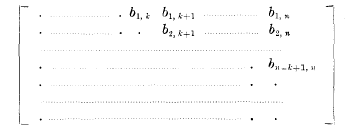Article contents
On the Canonical Form of a Rational Integral Function of a Matrix
Published online by Cambridge University Press: 20 January 2009
Extract
It is well known that the square matrix, of rank n−k + 1,

which we shall denote by B where any element to the left of, or below the nonzero diagonal b1, k, b2, k + 1, . …, bn−k + 1, n is zero, can be resolved into factors Z−1DZ; where D is a square matrix of order n having the elements d1, k, d2, k + 1, . …, dn−k + 1, n all unity and all the other elements zero, and where Z is a non-singular matrix. In this paper we shall show in a particular case that this is so, and in the case in question we shall exhibit the matrix Z explicitly. Application of this is made to find the classical canonical form of a rational integral function of a square matrix A.
- Type
- Research Article
- Information
- Copyright
- Copyright © Edinburgh Mathematical Society 1932
References
page 135 note 1 Proc. Akad. Amsterdam, 35 (1932), 157.Google Scholar
page 135 note 2 References to the original investigation by Frobenius, and to others, are given by Turnball and Aitken, Canonical Matrices (Glasgow, 1932), 81.Google Scholar
page 139 note 1 See Canonical Matrices, 67.Google Scholar
- 3
- Cited by


